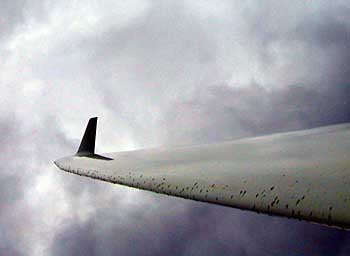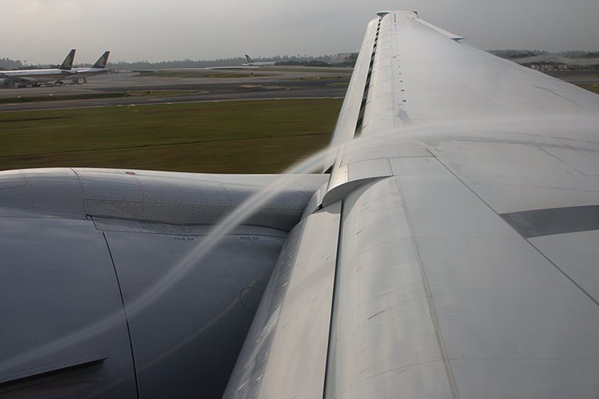Flight tests have shown that insect impacts on wing leading edge surfaces can leave residue with critical heights sufficient to disrupt laminar flow and decrease fuel efficiency. Since maintenance of laminar flow is most critical during cruise, insect residue adhesion mitigation is an operational necessity for fuel-efficient configurations. Fayette Collier, director of NASA’s Environmentally Responsible Aviation program, says giving bugs the brush off could shave 0.5% off fuel costs, or $240 million in savings.

NASA has patented a process to modify a surface to provide reduced adhesion surface properties to mitigate insect residue adhesion.
The surface is topographically and chemically modified by spray deposition of a polymer particulate composition comprising a nanocomposite material where the nanocomposite material comprises silica nanoparticles.

The topography is modified to create unevenness by either additive or subtractive methods including: lithographic patterning, laser ablation and chemical etching, physical vapor deposition, chemical vapor deposition, vapor phase deposition, crystal growth, electrochemical deposition, spin casting, and film casting. The unevenness is imparted and defined in terms of a defined or random pattern of unevenness on the surface.

The invention can be used to reduce the adhesion of insect residue on various surfaces such as airplane, helicopter, airborne vehicles, automobiles, marine vessels, motorcycles, helmets, wind turbines, all-terrain vehicles, floors, building, exterior walls or windows, etc.
Publication number: US 9278374
Patent Title: Modified surface having low adhesion properties to mitigate insect residue adhesion
Publication date: 8 Mar 2016
Filing date: 10 Jun 2013
Inventors: Christopher J. Wohl, Jr.; Joseph G. Smith, Jr.; Emilie J. Siochi; Ronald K. Penner;
Applicant: The United States of America as represented by the Administrator of the National Aeronautics and Space Administration
